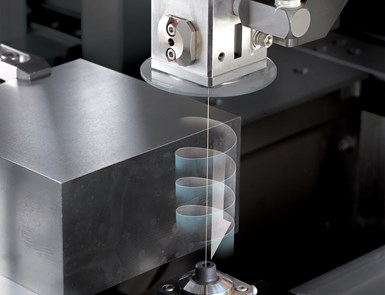Rotating Wire Function Cuts EDM Wire Consumption, Optimizes Mold Cutting Conditions
Sodick puts a new spin on its ALN and ALP wire EDM line with a new function that reduce wire consumption by 25% and improve the geometric accuracy and surface quality of workpieces.
With the addition of the patented wire rotating function, iGroove, Sodick says it has literally put a new spin on the capabilities of wire EDMs. Featured in the company’s ALN and ALP wire EDM lines, the addition of iGroove reportedly show improved results in accuracy and surface quality while simultaneously reducing wire consumption — this machine lineup is especially suited for thick workpieces (60 mm or greater).
The iGroove function rotates the wire from the top to the bottom of the workpiece, ensuring the entire surface of the wire is used during the cut, and eliminating the need for taper compensation due to wire wear. This twisting mechanism creates a consistent, fresh electrode surface from the top of the workpiece to the bottom, Sodick notes, and, as a byproduct, the wire feed speed can also be slowed down. This leads to reduced wire use without drawbacks such as excessive electrode damage — initial trials are said to have shown a 25% reduction in wire consumption on any given workpiece, with additional savings seen on cuts that require multiple skim cuts. Moreover, the iGroove series have shown increases in accuracy, surface finish and wire savings of up to 39%. Wire speeds are sourced from the built-in ALN conditions.
With the ALN’s 2D Automatic Programming Support function, Heart NC, machining and mold shapes capabilities are more possible than ever, Sodick says. There are options for involute gears, coreless shapes, and free-form curves for intentional designs. Using IntelligentQ3vic, 3D solid models can be imported directly, enabling the operator to establish a consistent and highly efficient manufacturing flow by automatically extracting machining contours from a solid model. With these functions, the ALN iGroove is ideal for moldmaking and other high-accuracy parts.
Related Content
-
Machine Hammer Peening Automates Mold Polishing
A polishing automation solution eliminates hand work, accelerates milling operations and controls surface geometries.
-
Solving Mold Alignment Problems with the Right Alignment Lock
Correct alignment lock selection can reduce maintenance costs and molding downtime, as well as increase part quality over the mold’s entire life.
-
Laser Welding Versus Micro Welding
The latest battle in finely detailed restoration/repair of mold materials.













